Did you know that you can navigate the posts by swiping left and right?
Easter Island Adventure - The Island
10 Nov 2017
. category:
Travel
.
Comments
#EasterIsland
Day 3: To the Island!
The day we’d been waiting for, onto Easter Island! Unsurprisingly, the flight was rather long, five hours, which I passed through some combination of sleeping and watching Wonder Woman. Be warned that these flights are unfortunately expensive, given the flight’s duration and lack of competition in this market (only LATAM flies the route). We paid over $700 roundtrip, despite booking decently early. For aviation geeks, Easter Island is also notable because there can only be a single inbound flight at any given time in the air (see here for more details). Following the map during the flight was a good reminder of how damn isolated the island is:
Upon arrival, we paid the national park entrance fee, and were greeted by someone from our hostel with a traditional lei, who nicely gave us a small tour of the island’s one “city,” Hanga Roa. It’s a bustling metropolis of 3000 people…the tour did not take long. It was also a bit challenging as his English was extremely rudimentary. Again, I found this quite surprising. Of all people, you would think that a hostel employee in an extremely heavily touristed area would speak at least passable English. I know, I know, I’m a spoiled American, but surprised nonetheless.
After settling in at the hostel, we walked down the main strip hoping to arrange a rental car, and perhaps a tour for our first day on the island. Provided you’re able to drive stick shift, rental cars on the island are extremely plentiful. In addition to two main rental agencies, basically every single business seems to also rent out the one or two cars their owners possess. Unfortunately, neither of us are able to drive stick, so we ended up with a rather expensive Suzuki Grand Nomade from one of the big rental agencies. Note that there’s no car insurance on the island, but luckily our Visa credit card benefit covered us (the same benefit that paid for the disastrous Iceland car debacle). We also arranged for a tour for the next day which would hopefully give us a useful overview and history.
We then embarked on a hike of Rano Kau, one of the three volcanic eruptions that formed Easter island. It was more of a real hike than we’d anticipated, but we did manage to make it up to the crater
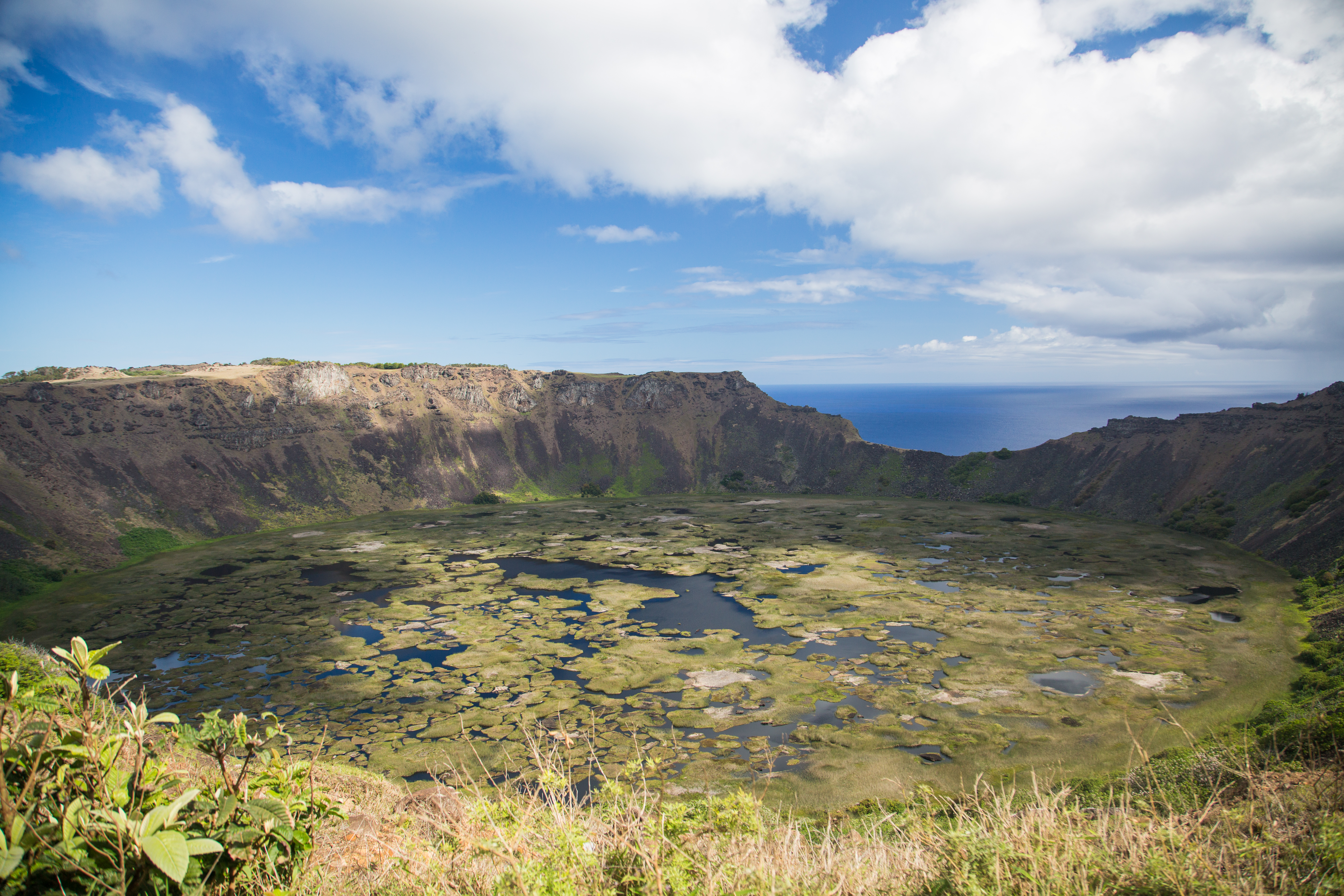
which was quite beautiful. We then had just enough time for dinner before catching the sunset. As I mentioned, Easter Island can be very expensive, so eating out for cheap is a tricky affair. But we’d vowed to only have peanut butter-based meals once a day, so we walked around in search of a reasonably priced restaurant. We ended up at a simple-looking place on the main street, where we each ordered an empanada as well as a seafood entree. Our waitress seemed a bit perplexed by our order, but her English was only slightly better than our non-existant Spanish so we weren’t sure why. It became clear when the empanadas showed up. We’d expected a small appetizer-sized portion, but instead it was basically massive enough to be a meal by itself, densely filled with (in my case) tuna, tomatoes, and onions. This is definitely a steal if you’re trying to eat for cheap on the island. I made a valiant effort, but didn’t quite finish.
We ended the day at Ahu Tahai, one of the most popular places to watch the sun set. An ahu is one of the stone platforms on which the statues were placed. Ahu Tahai has five moai, and makes for a great sunset, as it’s on the West side of the island:
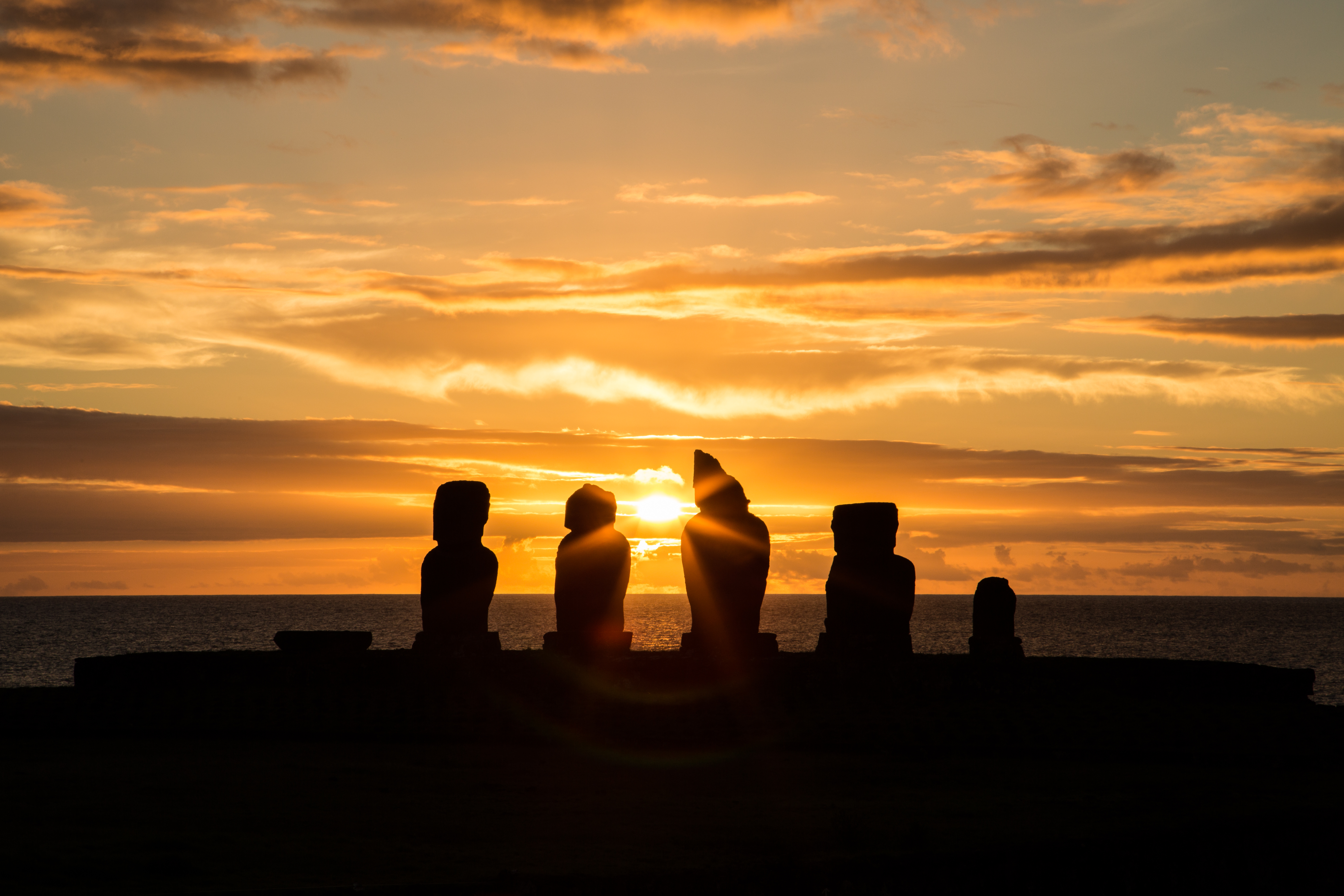
(picture by Lucy - the ones taken on my Pixel weren’t nearly as good). We then went back to the hostel and tried to nail down our post-tour schedule for the following day. Unfortunately, the hostel’s WiFi just didn’t cooperate, which would end up biting us the next day. WiFi was generally pretty spotty and slow the entire time on the island, which I guess isn’t surprising given its remoteness. As far as I can tell, there isn’t an undersea cable to Easter Island, though it looks like a planned one to China may stop there.
Day 4: Easter Island
We booked a tour for this day, as it was about the same price as a car rental, but included lunch as well as an English guide. While I don’t regret it, in hindsight I’m not sure how much value it added over just wandering around the island ourselves, given that we already knew the history highlights. If you’re able to get a cheaper car rental, or have a group of more than two people, I’d suggest skipping a tour.
We started the day off at Rano Raraku, the quarry where the moai were carved out of the rock. There are also a large number of moai on the outskirts of the quarry that are partially buried in the dirt. Our guide explained that these were unsatisfactory in some way, so they weren’t transported to ahus, and didn’t have proper hollowed out eyes. They do however, make for some great photos:
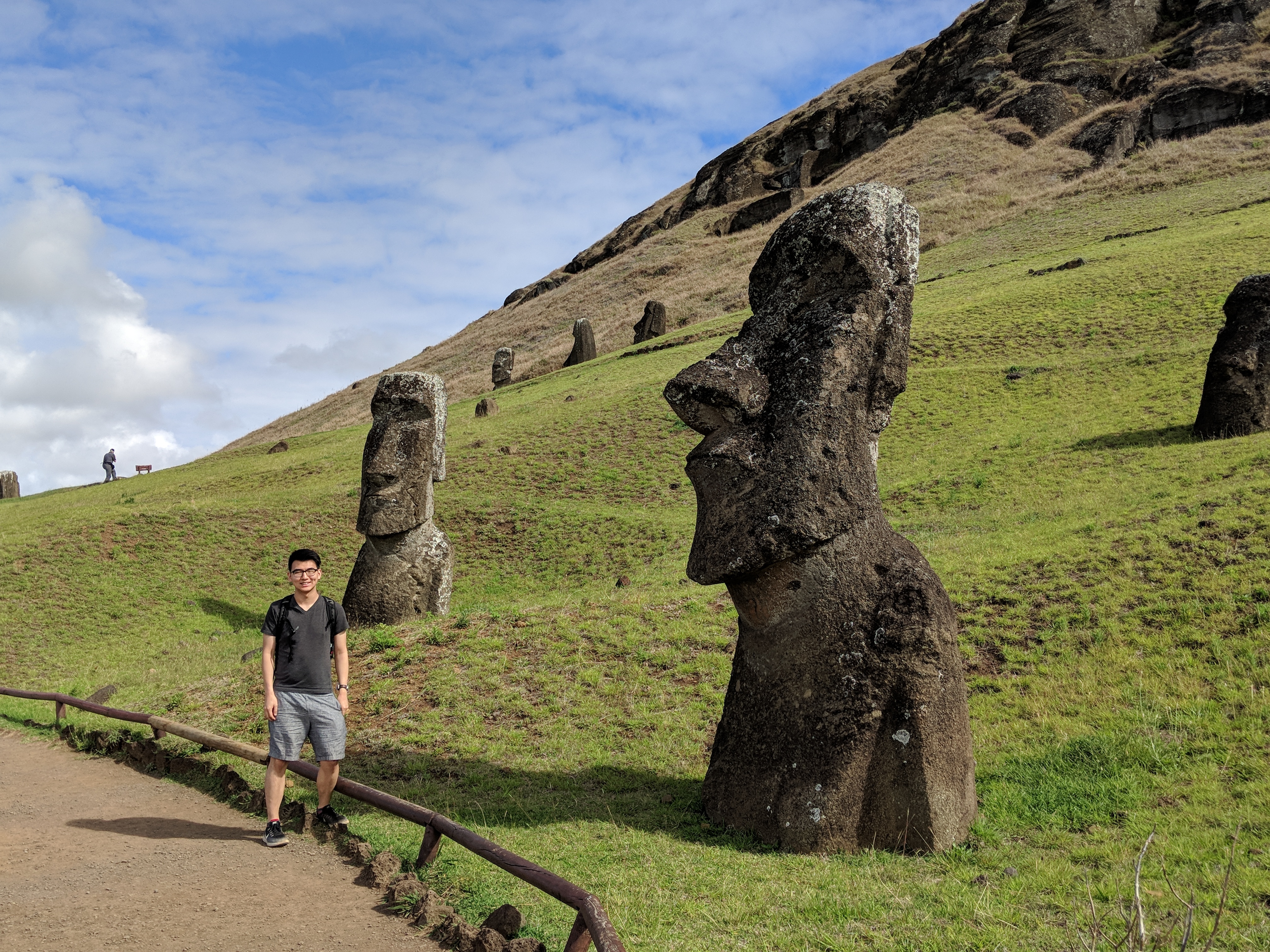
There are even some moai that seem to have fallen/broken during transport. Note the sign asking us to not stomp on the statue:
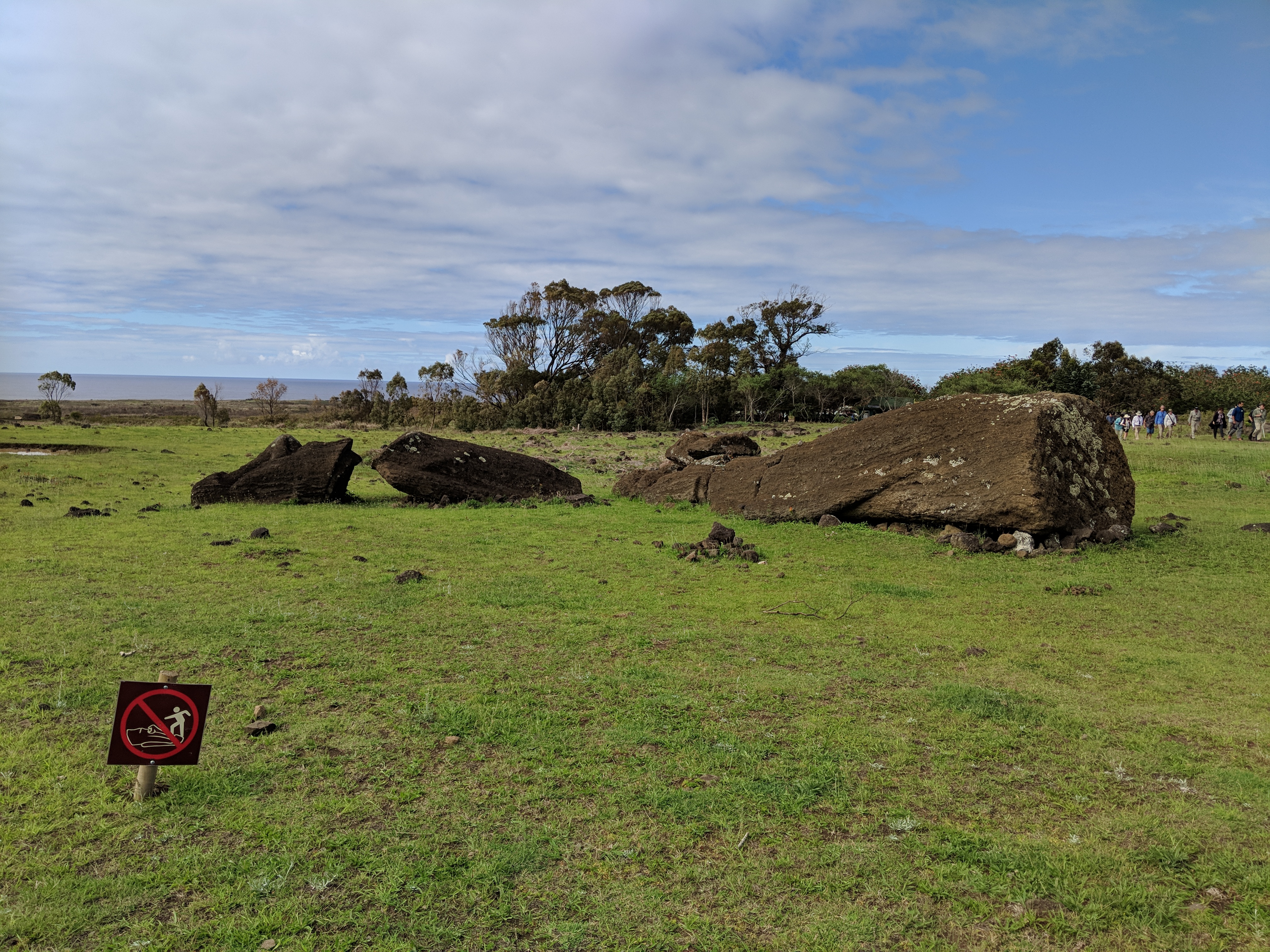
Seeing the moai in various states of “construction” really drives home just how much energy was expended in carving these things out of the rock, not to mention the immense transportation costs (they average 20 tons). It looks like estimates wildly vary, but some scholars have claimed that the largest moai took a team of six over a year to finish. It was also here at the quarry that we saw the National Geographic around-the-world tour for the first time. They really were incredibly organized, with each small group wearing nametags and matching backpacks, listening to their mic’d guide explain the history. But for eighty grand, I guess you’d expect nothing less.
The next stop was Ahu Tongariki, the largest ahu on the island, with 15 moai. This was the most impressive sight on the island in my opinion, given its scale:
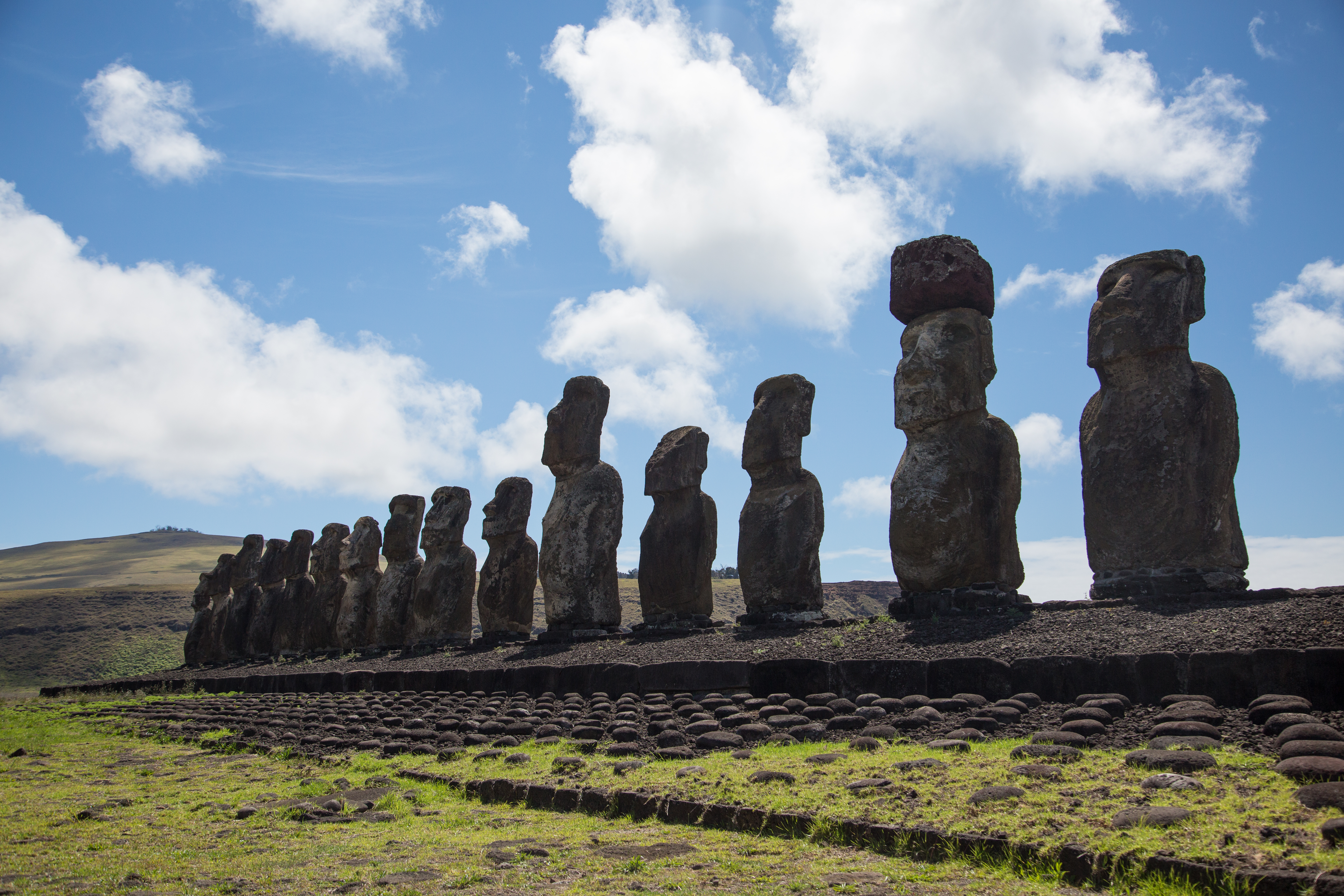
We even took one cheesy tourist photo!
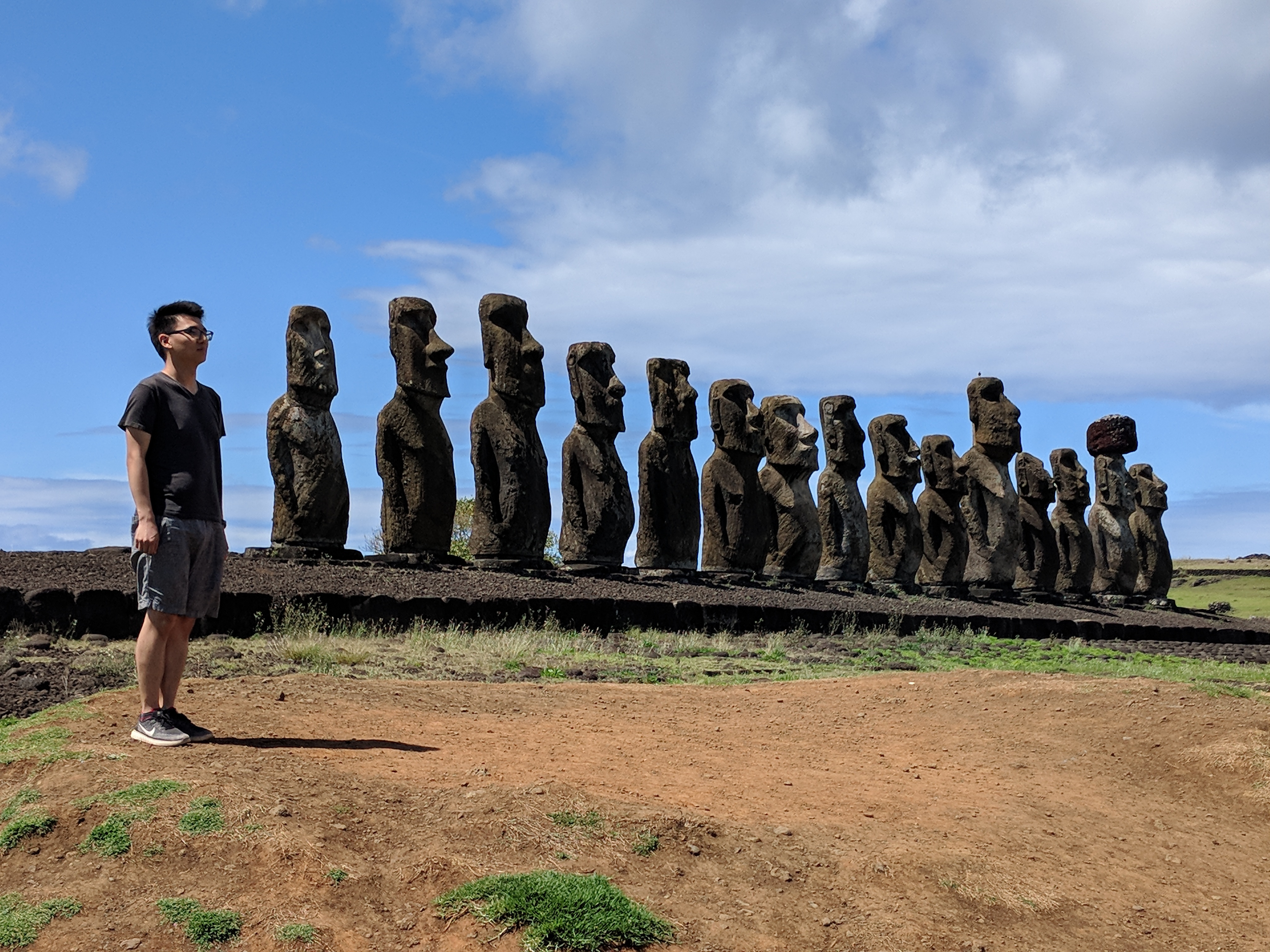
We were planning to return the next morning for sunrise here, but it was cool to see it during normal daylight conditions.
We then made our way to the Navel of the world, a smooth stone believed to have some sort of magical powers. It was…a smooth stone:
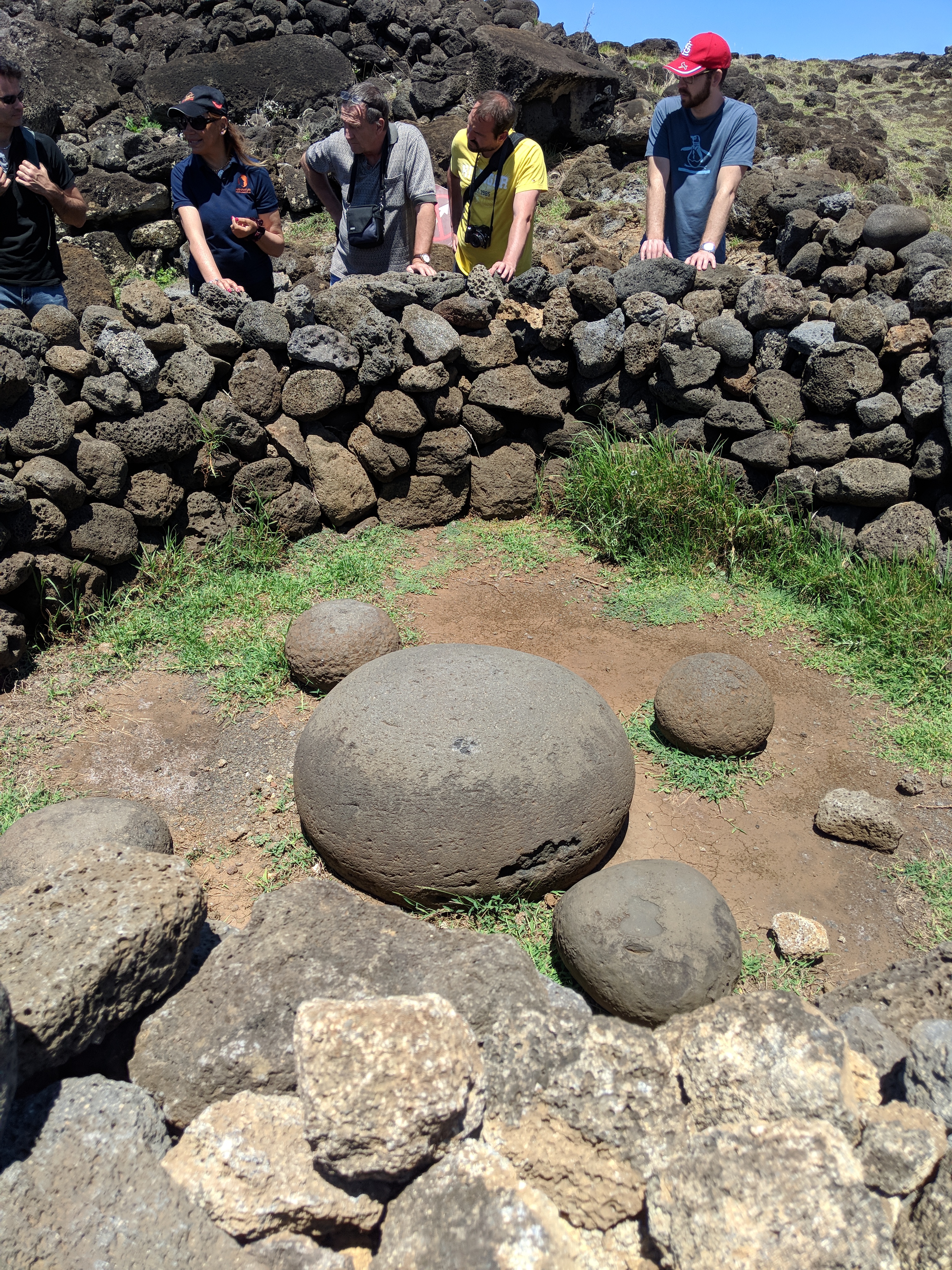
Our final stop on the tour was Anakena Beach on the north side of the island. It’s said to be where King Hotu Matu’a first landed upon his arrival. We relaxed here for about an hour, dipping our toes into the ocean. We were also treated to another great sign asking us to not touch the statues:
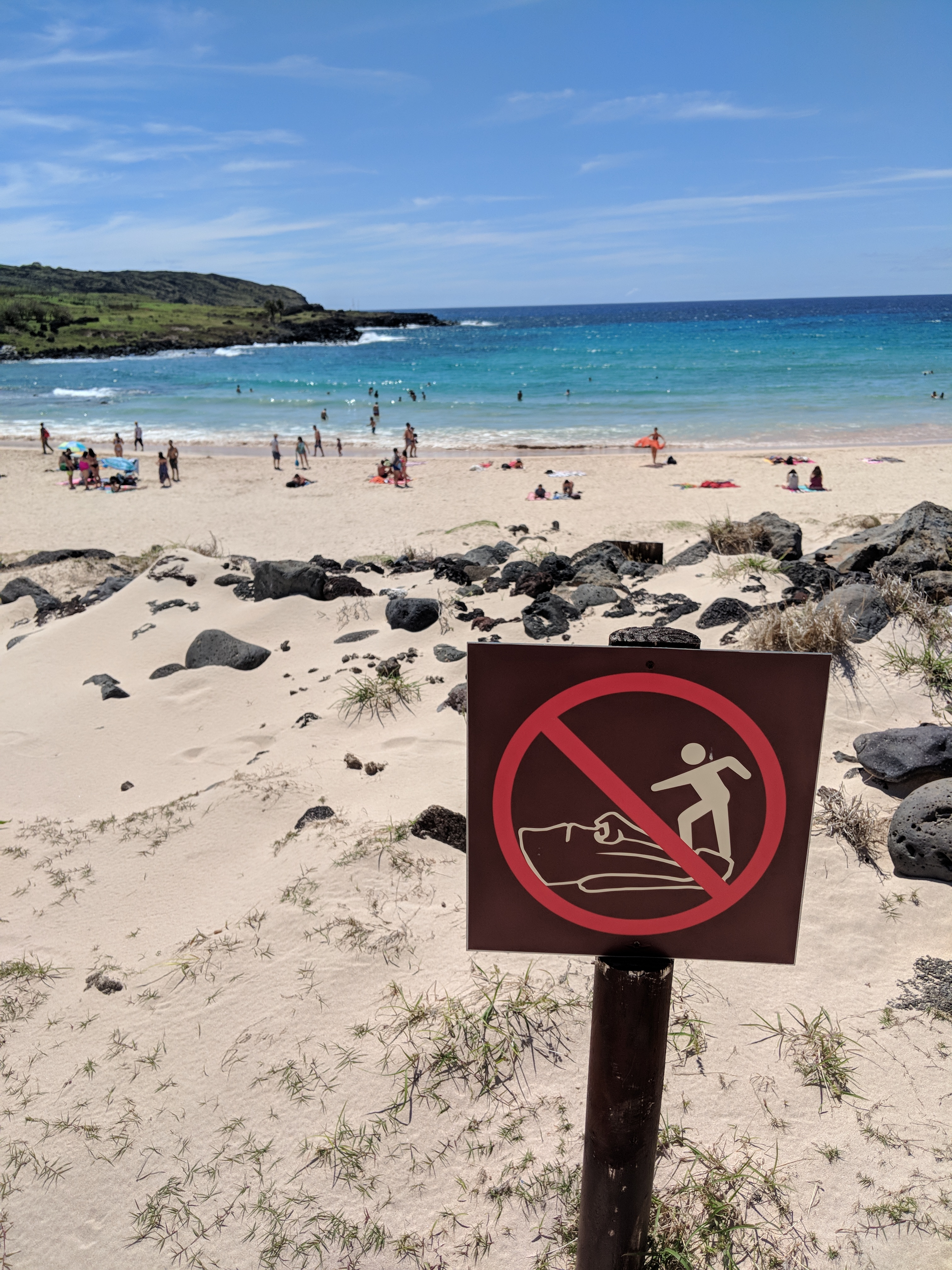
This is also where Ahu Nau Nau is, notable because of moai’s red pukaos. Not satisfied with just creating these immense stone rocks, the Rapa Nui people also carved hats/top-knots out of a red rock and placed them on top of the statues:
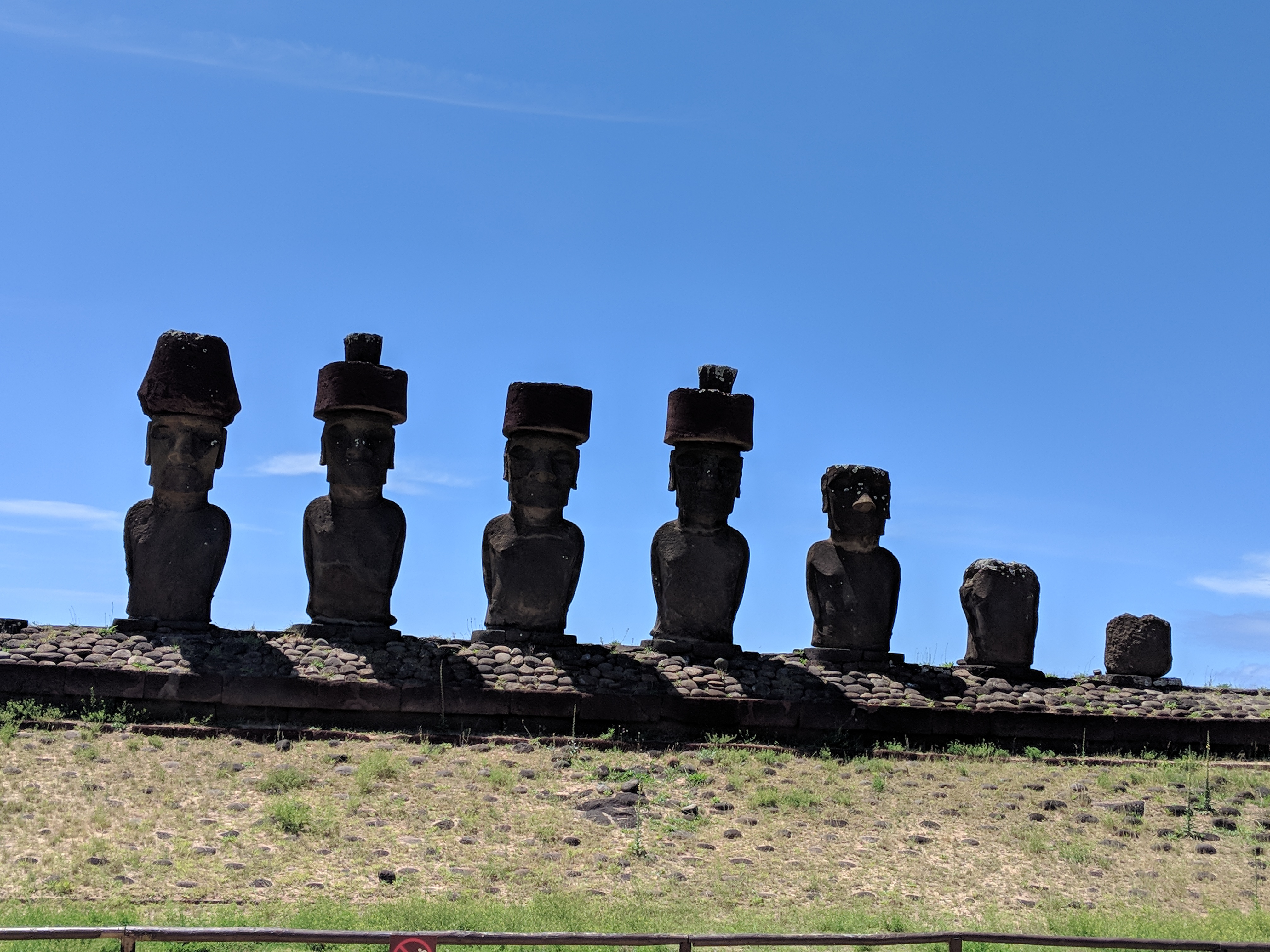
From here it was back to Hanga Roa, where we picked up our sturdy rental car. We were going to Ana Kakenga, a lava tube cave accessible via a small hole in the ground, which after some crouched walking, opens up into a central area with two openings to the sea, through which the view is incredible:

Unfortunately, we hadn’t been able to properly do our research about how to get there. But, the woman at the rental car place had given us pretty clear instructions, as well as a simplified map of the Island and its roads. So, we set off for the cave, knowing we’d need to walk the last little bit. But of course, the driving instructions given to us were just plain wrong. As far as I could tell, and I did more digging later with better internet, the road she told us to take dead-ended nowhere close to the cave. Regardless, we were a bit perplexed when the road turned from paved to dirt, and then got quite a bit sadder when our car got stuck in some pretty deep mud. But it’s alright, because we were driving the Suzuki Grand Nomade right? Sadly, turns out the car doesn’t really live up to its name, missing, e.g., 4WD or AWD. So, we spent the next hour inserting broken branches and our floor mats under the stuck wheels, mostly without success. With almost no cell reception and fading daylight, we were getting pretty panicked. But just at the one hour mark, we managed to get it unstuck, and headed back to town, unsurprisingly a bit muddy. Advice to anyone reading this blog, don’t ever travel somewhere with me that requires renting a car, I’m two for two on getting them stuck in snow/mud. Also, don’t trust directions given to you by rental car employees, even if the island seems so small that it would be impossible to get lost…
Day 5: Redemption
We started bright and early this day, setting out to see the sunrise at the previously visited Ahu Tongariki (can you tell Lucy’s into photography?). Anyway, we got a pretty good sunrise which was nice:
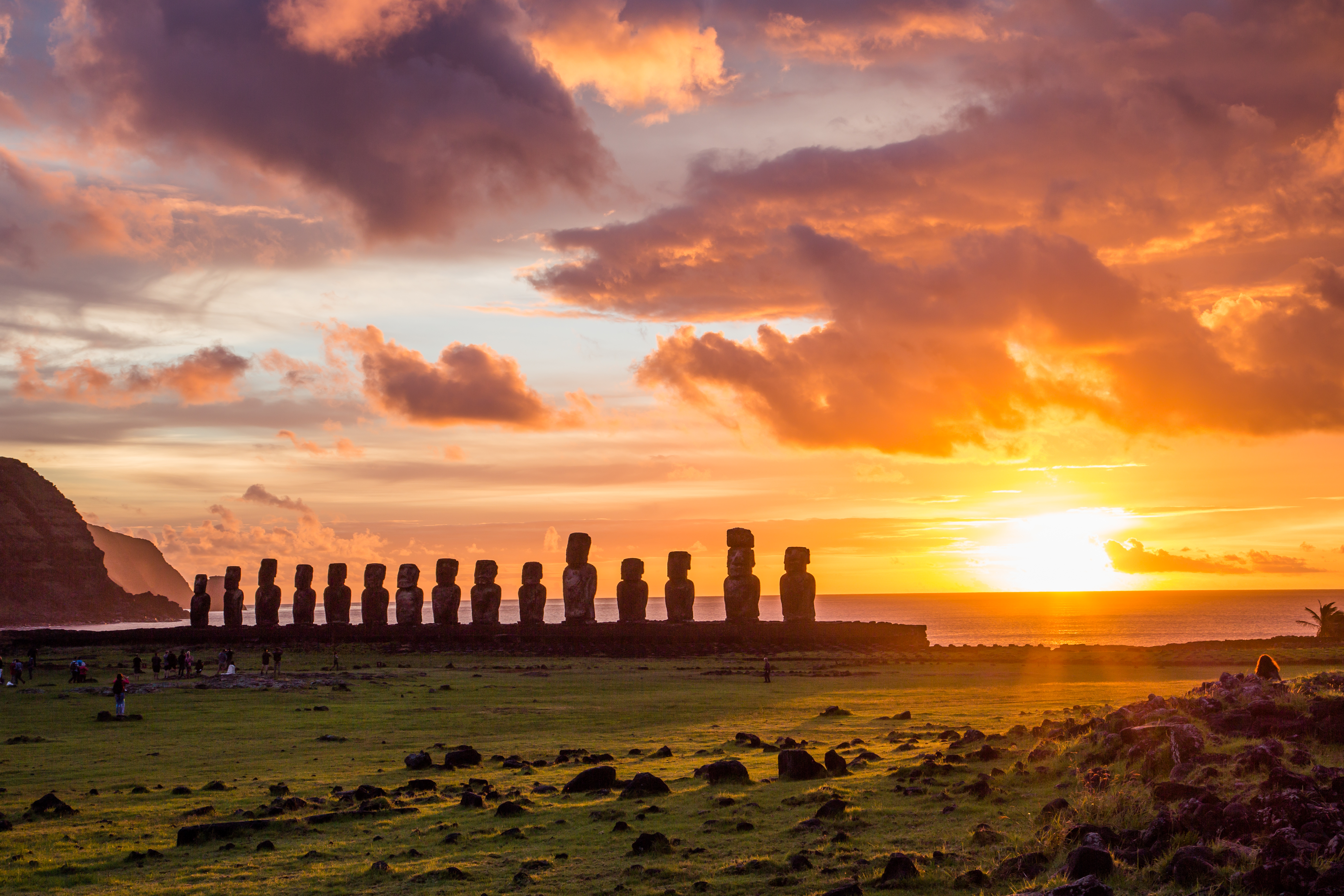
(again, photo by Lucy). We also ran into the NatGeo people again, or at least a subset of them. There seemed to be a designated photography pro traveling with them, which I guess is unsurprising. Perhaps he used to work for the magazine, and is now raking in the dough as a luxury photography guide. Seems like a pretty cool life. What was less cool was his constant narrative, calling out his f-stops and white balances and…oh well.
After sunrise, we drove to the preserved ceremonial village of Orongo. We hadn’t quite made it here on our first day, as it’s on the far side of Rano Kau’s rim. Our guide had mentioned that Orongo was a must see, so we dutifully drove up there and walked through the archeological village. It’s definitely interesting from a historical perspective, as it represents the new belief system adopted by the islanders as the resources on the island became more scarce. They apparently lost faith in their traditional chiefs and the moai, instead believing in the “birdman cult.” As described here:
Between warring clans and diminished resources, Rapa Nui’s population plummeted. One of the last remaining sources of sustenance were seabirds and their eggs, and the creatures’ ability to fly and fish earned the islanders’ reverence. A religion arose, and numerous festivities were held in Orongo, which dramatically sits on a narrow ridge along the island’s southern tip. The most noted event was a competition that pitted young champions from each clan, who plunged off Orongo’s 1,000-foot cliffs and swam through shark-infested Pacific waters to Motu Nui, a small island about a mile away. After returning with the egg of a sooty tern, the winner was crowned “Tangata Manu” (“Bird-Man”) and made leader for the year.
But I’m not sure visiting the village itself adds much to this historical knowledge, other than making clear how difficult this journey would’ve been for the young men competing.
We stopped for lunch at Ahu Akivi, notable because it’s the only ahu where the moai face out to the sea instead of in towards the island. We also celebrated having our last peanut-butter based meal.
The afternoon was spent finally making it to Ana Kakenga. We hiked the circuit mentioned here from Ahu Akivi, instead of walking up the coast from Ahu Tahai. In hindsight, this was probably a mistake. As while the former had a couple of interest points along the way, it was overall a pretty boring trek. I imagine walking up along the water would’ve been much more pleasant. Regardless, we did finally make it, or at least, we approximately made it. The directions online were a bit hazy about the location of this cave, and they all said it was a basically hard-to-find hole in the ground. So, when my Google Maps blue dot was about in the right place, we left the trail to go looking for it, basically running around in the rocky wilderness peaking behind rock formations for a cave. If this brings back memories, it’s because I did basically the same thing in Iceland looking for another cave. It turned out that we weren’t quite in the right place, and needed to go a couple hundred yards further. We thankfully ran back to the main trail when we saw some other tourists, and they pointed us in the right direction. I’m not sure what we would’ve done otherwise… And of course, just like in the Iceland case, the cave was actually not hard to find at all. There was a huge sign announcing the turn-off from the trail! Lesson learned twice now: if something is a well-known tourist attraction billed as “hard to find,” there’s probably a huge sign announcing it…oops. The cave itself was pretty incredible. As advertised, it’s basically a hole in the ground:
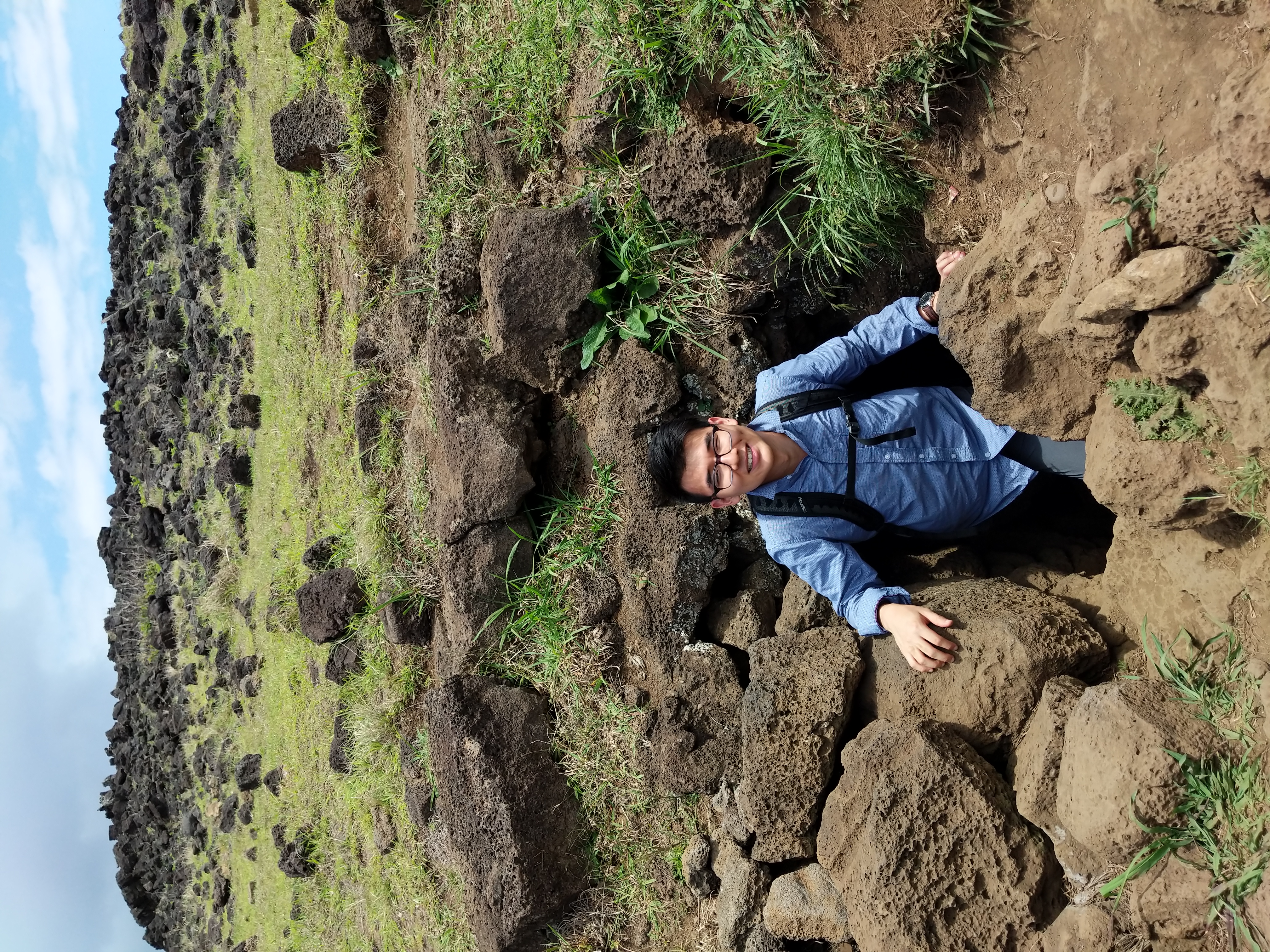
You have to crouch incredibly low through a short passage way, before it opens out into a cavernous area, from which there are two tunnels out to the cliffs. How this place was discovered, I have no idea. Here’s a bad photography attempt of the cavernous area:
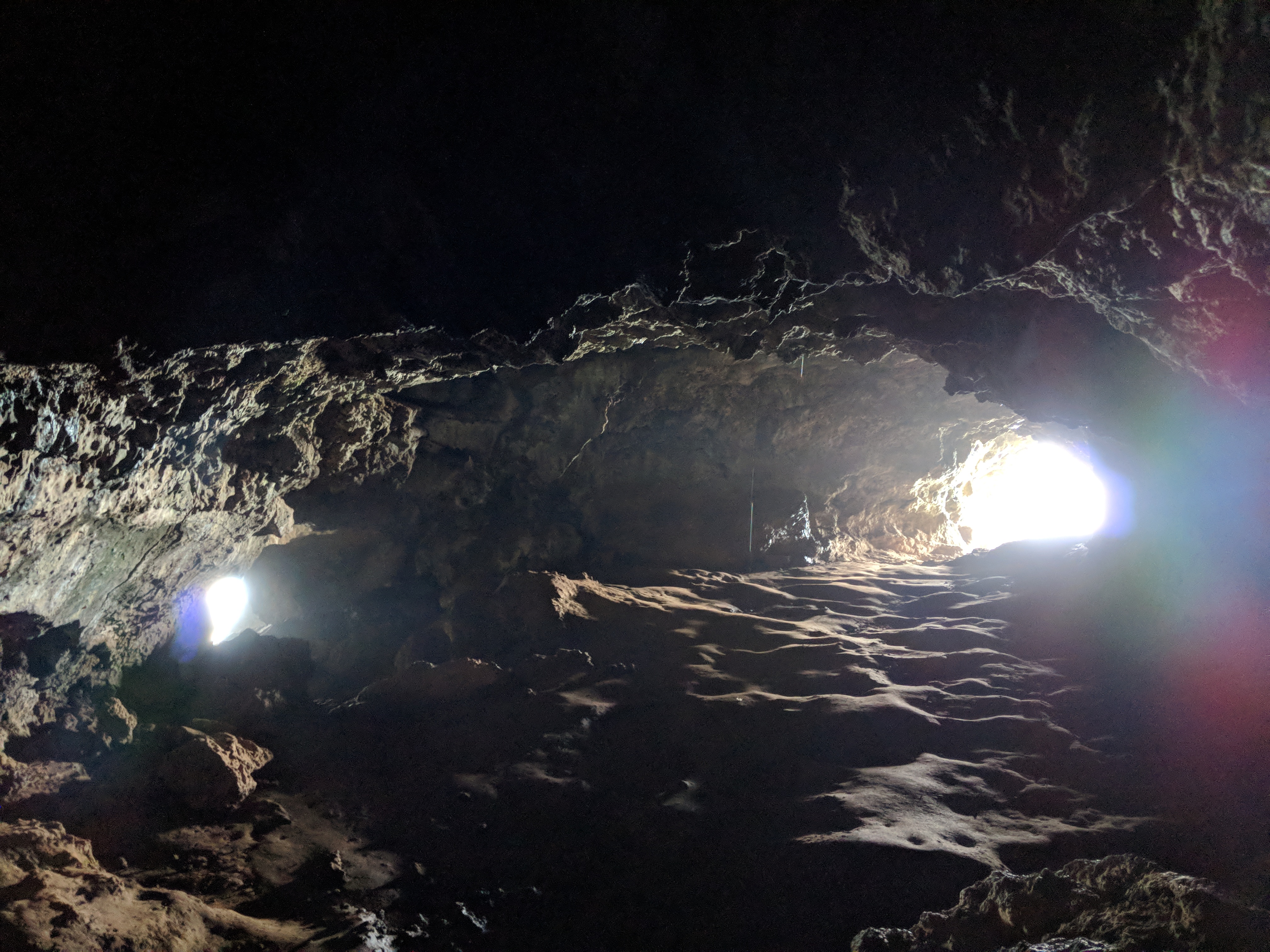
and then close to one of the openings:
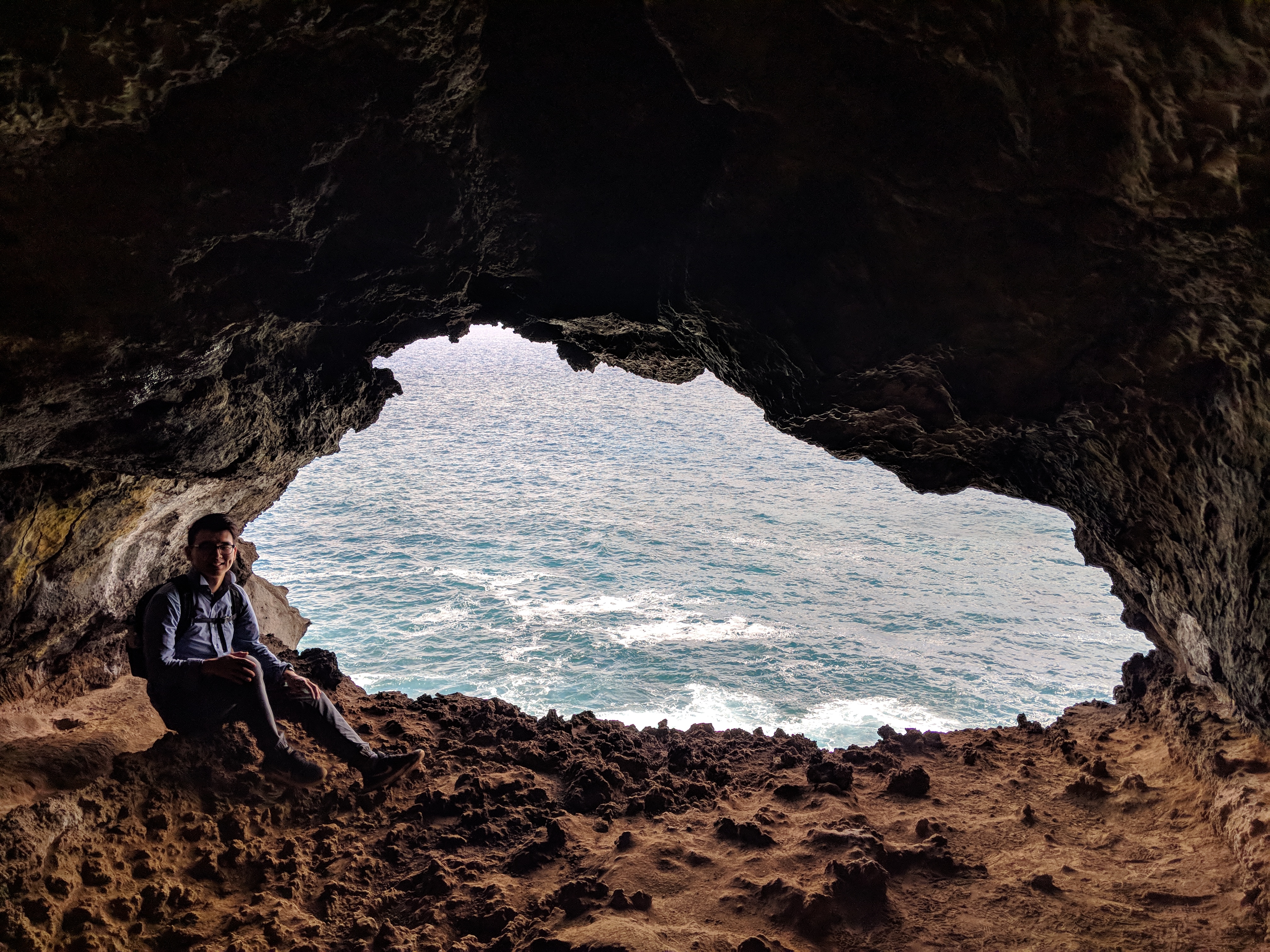
I didn’t dare get any closer. From here it was back to our car, and then to the gas station to fill it up. We didn’t really know the size of the tank, so we first just gave them a conservative estimate. This turned out to be insufficient, so we forked over a bit more, and which resulted in filling way past where we needed to…oh well. We’d been a bit concerned about the state of our car, given the tribulations in the mud, but it was accepted without question. Though we had spent some time rinsing it with a hose at our hostel, before the owner came angrily running out at us and we had to stop (another employee had told us it was okay).
Day 6: Leaving the Island
This day was pretty uneventful, we just flew back to Santiago and checked back into the hostel we’d stayed at before. Getting onto the plane, there was a woman with a child in my seat, which was a bit weird. And she did indeed have the same seat assignment as me. It seems like whatever technology airlines use should really really make sure that this can’t happen, but evidently LATAM’s isn’t great. After some confusion, I got upgraded to the bulkhead row, which was pretty nice. But the adventure continues, as the two seats next to me were taken by a nurse carrying a huge medical bag and an obviously very sick older man. I imagine he was heading back to the mainland for medical care something? Then, right before take off I was asked to move again, this time to business class, score! First time getting upgraded like that, my plane luck this trip was really amazing.
Less good was our attempt to Uber to our hostel from the airport. First of all, the app completely lied about the amount of time needed to get a ride. It probably took 20 minutes for us to actually get a car (it timed out our requests several times). Then, despite Uber’s very clear instructions about the meeting point, our driver couldn’t find us at all, and seemed to be randomly circling around us, though I couldn’t ever find her vehicle. Eventually, she cancelled and we went through this whole process again, with greater success. All in, we spent about an hour waiting outside. We probably should’ve given up at some point, but some combination of sunk cost fallacy and distrust of local taxis kept us waiting. My attempts after the fact to understand why we had such a terrible experience were met by basically the worst customer service I’ve ever had - repeated canned responses that completely ignored the texts of my emails. I’m now on Team Lyft/Via.
The rest of the evening was pretty uneventful, dinner and then packing again for our early morning bus ride through the beautiful Andes!